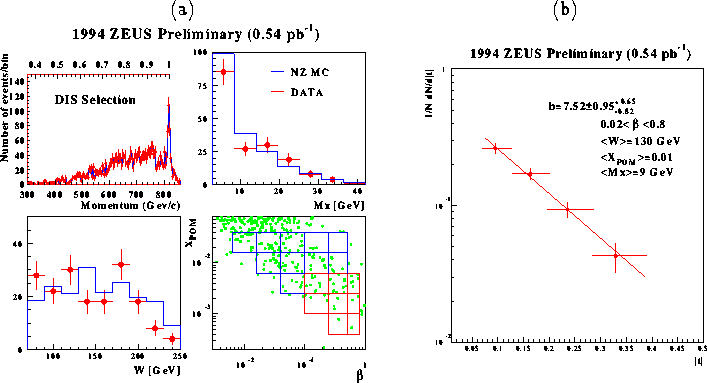The advent of the leading proton spectrometers (LPS) at HERA is especially
important in these diffractive measurements, since internal
cross checks of the measurements as a function of t, M2, W2 and Q2
can ultimately be performed
and underlying assumptions can be questioned experimentally. Only in these
measurements can we positively identify the diffracted proton and hence
substantially reduce uncertainties on the non-diffractive and double
dissociation backgrounds. However, new uncertainties are introduced
due to the need for precise
understanding of the beam optics and relative alignment of the detectors.
Reduced statistical precision also results due to the
geometrical acceptance of the detectors ( ![]() 6%).
In figure 11(a), various observed distributions are shown for
240 events selected from the DIS data, with
6%).
In figure 11(a), various observed distributions are shown for
240 events selected from the DIS data, with ![]() GeV2.
The momentum distribution clearly indicates a significant diffractive
peak at Ep = 820 GeV above the non-diffractive background and the observed
M and W distributions are well described by the NZ Monte Carlo [38].
The distribution of
GeV2.
The momentum distribution clearly indicates a significant diffractive
peak at Ep = 820 GeV above the non-diffractive background and the observed
M and W distributions are well described by the NZ Monte Carlo [38].
The distribution of ![]() versus
versus ![]() indicates a significant fraction
of events at small
indicates a significant fraction
of events at small ![]() which are difficult to access using the
experimental techniques described earlier. The measurements are currently
being analysed, but a preliminary result on the t-dependence is shown in
Figure 11(b), measured in a relatively high observed
mass interval,
which are difficult to access using the
experimental techniques described earlier. The measurements are currently
being analysed, but a preliminary result on the t-dependence is shown in
Figure 11(b), measured in a relatively high observed
mass interval, ![]() GeV,
at relatively low Q2. The slope can be characterised by
a single exponential fit with
GeV,
at relatively low Q2. The slope can be characterised by
a single exponential fit with
![]() .
This is somewhat high compared to
the value of
.
This is somewhat high compared to
the value of ![]() expected for a predominantly hard pomeron
but lies within the range of expectations of
expected for a predominantly hard pomeron
but lies within the range of expectations of ![]() .
However, before drawing conclusions, we should perhaps wait for further
results on the general dependences measured in the LPS.
.
However, before drawing conclusions, we should perhaps wait for further
results on the general dependences measured in the LPS.

Figure 11: (a) Observed momentum, M, W and ![]() versus
versus ![]() distributions in the LPS. The observed M and W distributions are
compared to the NZ Monte Carlo predictions. (b) Corrected t distribution
in the quoted range.
distributions in the LPS. The observed M and W distributions are
compared to the NZ Monte Carlo predictions. (b) Corrected t distribution
in the quoted range.